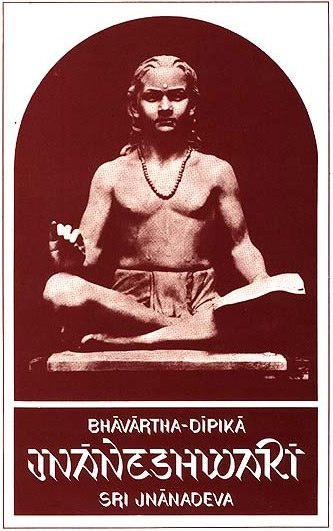Jnaneshwari (Bhavartha Dipika)
by Ramchandra Keshav Bhagwat | 1954 | 284,137 words | ISBN-10: 8185208123 | ISBN-13: 9788185208121
This is verse 8.9-10 of the Jnaneshwari (Bhavartha-Dipika), the English translation of 13th-century Marathi commentary on the Bhagavad-Gita.—The Dnyaneshwari (Jnaneshwari) brings to light the deeper meaning of the Gita which represents the essence of the Vedic Religion. This is verse 9-10 of the chapter called Akshara-brahman-yoga.
Verse 8.9-10
Verse 8.9: “Whoso would ponder upon that Primal Architect and Law-Giver, subtler than the subtle, the Sustainer of everything, whose form transcends thought, and who is effulgent like the Sun, and on the off-side of darkness:
Verse 8.10: “With steadfast mind, fixed in devotion, and by the power of Yogic practice correctly reposing, at the lime of departure, the life-function (Prana) betwixt the eyebrows: he attains that Person, Supreme and Divine. (86)
Commentary called Jnaneshwari by Jnaneshwar:
He, with tranquil mind, meditates at the time of his death, on the Perfect Brahman,—which is Pure Being without form or space, beyond birth and death, and all-pervading and all-seeing, which was prior to the sky itself, and which is more minute than an atom, and by whose power the Universe moves, which creates all that is visible, on which the entire Universe survives, from which reason turns away, and which is thus beyond the power of thought. It remains invisible darkness to the physical eye, even during day time, in the way the white ants cannot enter into fire, or darkness cannot enter into brilliance. It is Pure Being that is like a heap of pounded, cleaned (crushed) grain in the form of Sun’s rays and which is ever an eternal light of seeing to persons that know, and in regard to which rising and setting are meaningless words.
He, at the time of his death remembers, meditating with tranquil mind (on) the Supreme Brahman of such flawless and perfect form; and he sits in the position named “Padma” facing north, with his mind imbued with the eternal bliss of the Yoga of active life, and and there eagerly awaits to be re-absored, with all his poses of mind united, in the essence of the Supreme Self, as speedily as he can, through his Yoga discipline, make the Sushumna (name of a nadi or tubular vessel of the body) pass along the middle passage from the Adhar to the region in the head known as Brahmarandhra; and when the life-wind named ‘Prana’ enters the sky in the region of the head, he feels as merely an outwardly show, the union of the body and others with the mind; but he sustains himself on the strength of the tranquillity of his mind and gets full with deep devotion; and he exists as one perfect and ready, getting tried by the power of Yogic Discipline. He extinguishes all that is dense as well as subtle in the universe and abides concentrating the life-wind between the eye-brows.
In such a tranquil state he leaves behind, his body (unperceived) in the way a light kept shut up under a pot gets extinguished or in the way the (metallic) sound of a bell gets extinguished in the bell itself. Such a one is the very Supreme Brahman. He abides in the form of the Self which is self-same and the very brilliance itself and which is known as the Supreme Male (Person) (paramapuruṣa).
